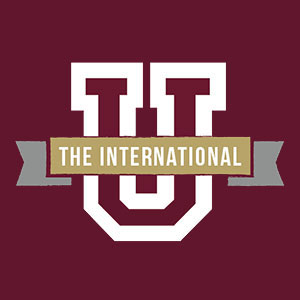TAMIU Goes Green

The ever-sage Shakespeare wrote, “One touch of nature makes the whole world kin.”
At Texas A&M International University, a soft “green touch” is aimed at deftly helping kin to become kindred.
TAMIU is keenly pursuing a Campus Sustainability Initiative that will expand on green practices already in place to render a campus that’s more energy efficient and environmentally sensitive.
From simple practices like raising building temperatures to complex undertakings like working towards incorporating LEED (Leadership in Energy and Environmental Design) in new buildings, the University aim is true: a greener TAMIU.
“We’re all being asked to conserve and concentrate our resources, and the University is no different. We can all do something in our daily lives to reduce our impact on our environment, to lessen our carbon footprint on the world. Through education, research and leadership, a University must do more,” said Dr. Ray Keck, TAMIU president.
Dr. Keck recalled a previous energy saving effort that hinged on a four-day work week in summer 2003.
“Acting on the Governor’s request, we sought to reduce our energy expenses by reducing our presence here. After 15 weeks, we only saved about $6000 and inconvenienced our programs and operations. Our buildings are so energy efficient that this experiment was quite doomed,” he recalled.
This year, the University began to explore other options for savings and sustainability.
“We have been working closely with The Texas A&M University System’s Texas Engineering Experiment Station’s Energy Systems Laboratory (ESL), which conducted a sustainability assessment here. We were impressed that so many of our ‘small’ efforts actually combine to create a powerful pre-emptive commitment to sustainability.
“The ESL assessment has provided us with a roadmap for a green campus initiative that we are eager to support as possible with appropriate budget, impact and interest considerations. Our ‘Green Team,’ including faculty, administration and students are spearheading our effort,” Keck said.
ESL’s TAMIU assessment by researchers Dr. David Claridge, P.E., professor of mechanical engineering, and Malcolm Verdict, C.E.M., associate director, was positive, noting strong TAMIU efforts already in place.
Among those: an automated irrigation control system, ongoing water conservation research, drought-tolerant vegetation, low-flow shower heads and toilets used in student housing, active recycling of all paper, metal, cardboard, and plastic as well as batteries, lights, and phones. TAMIU computers are recycled through a state program that sends them to a correctional facility.
In addition, the University has an energy conservation campaign in place, strengthened by automatic lighting controls in all classrooms and most offices. It purchases recycled content paper for the entire campus and maintains a no-smoking policy around buildings. TAMIU is a 100 percent asbestos-free campus, researchers noted.
Campus grounds boast a great deal of preserved green space including substantial tree planting, campus lighting that minimizes light pollution and grounds maintenance that incorporates an Integrated Pest Management System with complete tracking and some use of organic pest control options.
The campus’ Master Plan through 2014 focuses on the campus’ core not infringing on the natural, open space, while maintaining a reserved a “Green Space” border around campus that will keep this area in its natural state. Researchers noted that the campus remains home to wildlife including a rich array of birds, white-tailed deer and javelinas.
The ESL team’s assessment revealed that the campus’ green push even extends to areas not commonly considered “green” outposts … like dining services.
The assessment notes that TAMIU Dining Services has healthy options such as a salad bar in the main dining facility and a Subway sandwich vendor, while organic foods are available for catered events and a wellness committee is active on campus.
Perhaps most importantly for an institution of higher education, the “green” spirit is already part of TAMIU teaching and learning.
The assessment noted that TAMIU sustainability-related courses include Environmental Science and Environmental Geology; while various sustainability-related research is already in progress, an engineering curriculum is started. Professors are willing to integrate sustainability into core courses, while students are getting involved through course project participation.
The assessment authors observed, “While TAMIU is well on its way to becoming a sustainable campus leader, there is much opportunity for improvement … this is only the beginning of a long, rewarding, more sustainable path for the University, now and in the future.”
“Dr. Keck’s TAMIU Green Campus Initiative is without parallel in the A&M System and serves as an outstanding example for counterparts to follow. It will also serve as a model for The Texas A&M University System and the surrounding community to subscribe,” the team notes.
Keck said both assessment and roadmap for the future are exciting and challenging.
“Over the next 10 years, our campus will probably double in size, affording us a significant challenge to expand on our efforts to create a green TAMIU.
“The benefits are many: reduced utility expenses, improved air quality, improved learning environment and reduced air, land and water impacts on environment. We can become a regional and national leader in sustainable educational advances. Most importantly, what great institution of learning would not want to help create a new generation of kindred resource and energy-conscious graduates?
“By thinking green now, we can live green for generations to come,” Dr. Keck said.
For more information, please contact the Office of Public Relations, Marketing and Information Services at 326.2180, prmis@tamiu.edu or visit offices in the Sue and Radcliffe Killam Library, room 268.
University office hours are 8 a.m. – 5 p.m., Monday through Friday.
Journalists who need additional information or help with media requests and interviews should contact the Office of Public Relations, Marketing and Information Services at prmis@tamiu.edu